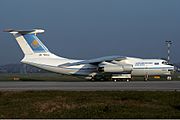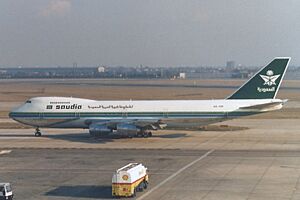1996 Charkhi Dadri mid-air collision facts for kids
| Accident summary | |
|---|---|
| Date | 12 November 1996 |
| Summary | Mid-air collision |
| Place | Charkhi Dadri, Haryana, India 28°33′38″N 76°18′15″E / 28.56056°N 76.30417°E |
| Total fatalities | 349 |
| Total survivors | 0 |
| First aircraft | |
HZ-AIH, the 747 involved, at London Heathrow, in 1986 |
|
| Type | Boeing 747-168B |
| Airline/user | Saudi Arabian Airlines |
| Registration | HZ-AIH |
| Flew from | Indira Gandhi International Airport, Delhi, India |
| Flying to | Dhahran International Airport, Dhahran, Saudi Arabia |
| Passengers | 289 |
| Crew | 23 |
| Fatalities | 312 |
| Survivors | 0 |
| Second aircraft | |
 UN-76435, the Ilyushin Il-76TD involved in the collision, at Düsseldorf Airport, in 1994. |
|
| Type | Ilyushin Il-76TD |
| Airline/user | Kazakhstan Airlines |
| Registration | UN-76435 |
| Flew from | Chimkent Airport, Kazakhstan |
| Flying to | Indira Gandhi International Airport, Delhi, India |
| Passengers | 27 |
| Crew | 10 |
| Fatalities | 37 |
| Survivors | 0 |
On November 12, 1996, two airplanes crashed in the sky over Charkhi Dadri, a village in India. One plane was Saudia Flight 763, a Boeing 747 flying from Delhi, India, to Dhahran, Saudi Arabia. The other was Kazakhstan Airlines Flight 1907, an Ilyushin Il-76 flying from Chimkent, Kazakhstan, to Delhi.
The collision happened about 100 kilometers (60 miles) west of Delhi. All 349 people on both planes died. This made it the deadliest mid-air collision in the world's history. It was also the worst aviation accident ever in India. The crash happened because the crew of the Kazakh plane did not stay at the correct altitude. This was due to problems communicating with the air traffic control tower.
Contents
The Airplanes Involved
Saudia Flight 763
Saudia Flight 763 was a Boeing 747 airplane. Its registration number was HZ-AIH. This plane was on a regular flight from Delhi to Dhahran and then to Jeddah. There were 312 people on board.
The crew included Captain Khalid Al-Shubaily, First Officer Nazir Khan, and Flight Engineer Ahmed Edrees. Captain Al-Shubaily was a very experienced pilot. He had flown for 9,837 hours. Most of the passengers were from India, with others from Nepal, Pakistan, America, Bangladesh, and the UK.
Kazakhstan Airlines Flight 1907
Kazakhstan Airlines Flight 1907 was an Ilyushin Il-76TD plane. Its registration number was UN-76435. This plane was on a special charter flight from Chimkent Airport to Delhi. There were 37 people on board.
The crew included Captain Alexander Cherepanov, First Officer Ermek Dzhangirov, Flight Engineer Alexander Chuprov, Navigator Zhahanbek Aripbaev, and Radio Operator Egor Repp. Captain Cherepanov was also very experienced, with 9,229 flight hours. Most of the passengers were from Kyrgyzstan, traveling to India for shopping.
The Collision in the Sky
Saudia Flight 763 took off from Delhi at 6:32 PM local time. At the same time, Kazakhstan Airlines Flight 1907 was flying down to land in Delhi. Both planes were being guided by the same air traffic controller, V.K. Dutta.
After taking off, the Saudia plane was told to fly up to 10,000 feet (about 3,050 meters). A few minutes later, the Kazakh plane was told to fly down to 15,000 feet (about 4,570 meters). Then, the Saudia plane was told to climb to 14,000 feet (about 4,270 meters).
At 6:38 PM, the Saudia crew said they had reached 14,000 feet and asked to fly even higher. The air traffic controller told them to stay at their current height. The Saudia pilot confirmed this.
At 6:39 PM, the Kazakh flight reported that they had reached 15,000 feet. However, they were actually higher, at 16,348 feet (about 4,980 meters), and still flying downwards. The controller then warned the Kazakh plane about the Saudia plane, which was 10 miles away and flying towards them at 14,000 feet. The Kazakh plane's radio operator asked for more information and then said they were looking for the other plane.
Less than a minute later, at 6:40 PM, a US Air Force cargo plane nearby reported seeing "a big explosion." The air traffic controller tried to contact both planes, but got no answer.
The two planes had crashed into each other. The left wing of the Kazakh plane cut through the left wing of the Saudia 747. Also, the tail part of the 747 cut off the tail of the Kazakh plane.
The damaged Saudia Boeing 747 quickly went out of control. It spiraled down with fire coming from its wing. The plane broke apart in the air before hitting the ground at a very high speed. The Ilyushin plane, missing its left wing and tail, spun flat and crashed into a field near the Saudia plane's wreckage. All 312 people on the Saudia flight and all 37 people on the Kazakhstan Airlines flight died.
The crash site was about 60 miles (96 kilometers) west of Delhi. The parts of the Saudia plane landed near Dhani village, while the parts of the Kazakh plane landed near Birohar village.
The Investigation and Findings
The crash was investigated by the Lahoti Commission, led by judge Ramesh Chandra Lahoti. They looked at information from the air traffic controllers and both airlines. The flight data recorders, which record what happens during a flight, were studied in Moscow and England.
The main reason for the accident was that the crew of Kazakhstan Airlines Flight 1907 did not follow the air traffic control instructions. They flew lower than they were told to. This happened because the Kazakh pilots had trouble speaking English. They relied on their Radio Operator, Egor Repp, to talk to the air traffic controller.
The report suggested that the pilots might have misunderstood the controller's last message. They might have thought the Saudia plane's altitude (14,000 feet) was their own assigned altitude. Also, the radio operator did not have his own flight instruments. He had to look over the pilots' shoulders to see the readings, which made it harder for him to know exactly what was happening. Kazakh officials said their plane went down because the pilots were dealing with strong winds inside clouds.
Indian air controllers also mentioned that Kazakh pilots sometimes got confused. This was because they were used to measuring altitude in meters and distance in kilometers, while most other countries use feet and nautical miles.
Just before the crash, the Kazakh plane climbed slightly. This happened because the radio operator realized they were not at 15,000 feet and told the pilot to climb. The pilot quickly increased power, and the plane went up, but it was too late. It hit the oncoming Saudia plane. If the Kazakh pilots had not climbed slightly, they might have flown under the Saudia plane.
The recording from the Saudia plane showed that the pilots said Islamic prayers before the plane hit the ground.
The investigation also found that Indira Gandhi International Airport did not have a secondary surveillance radar. This type of radar gives extra information like the plane's identity and altitude. Instead, the airport only had a primary radar, which only shows distance and direction. Also, planes arriving and departing Delhi used the same air path. Most airports have separate paths for incoming and outgoing flights. In Delhi in 1996, much of the sky was used by the Indian Air Force, leaving only one path for civilian planes.
Because of this crash, the investigation report suggested important changes for air traffic in New Delhi:
- Creating separate air paths for planes flying in and out.
- Installing a secondary air traffic control radar to get altitude data.
- Making it required for all commercial planes in Indian airspace to have collision avoidance equipment.
- Reducing the amount of airspace controlled only by the Indian Air Force.
What Happened After
After the accident, the Directorate General of Civil Aviation in India made it mandatory for all planes flying in and out of India to have an airborne collision avoidance system. This was a big step and led to the worldwide requirement for planes to use TCAS.
As of 2021, there are plans to build a memorial in Charkhi Dadri to honor the victims of the crash. This memorial would include the names of those who died. The local government is working to get approval for this project.
Documentaries About the Crash
- A company called Miditech made a documentary about the disaster called Head On!. It was shown on the National Geographic Channel.
- The crash was also featured in an episode of the TV series Mayday (Air Crash Investigation) called "Sight Unseen." This episode also aired on the National Geographic Channel.
See also
 In Spanish: Colisión aérea de Charkhi Dadri para niños
In Spanish: Colisión aérea de Charkhi Dadri para niños
- List of accidents and incidents involving airliners by airline



